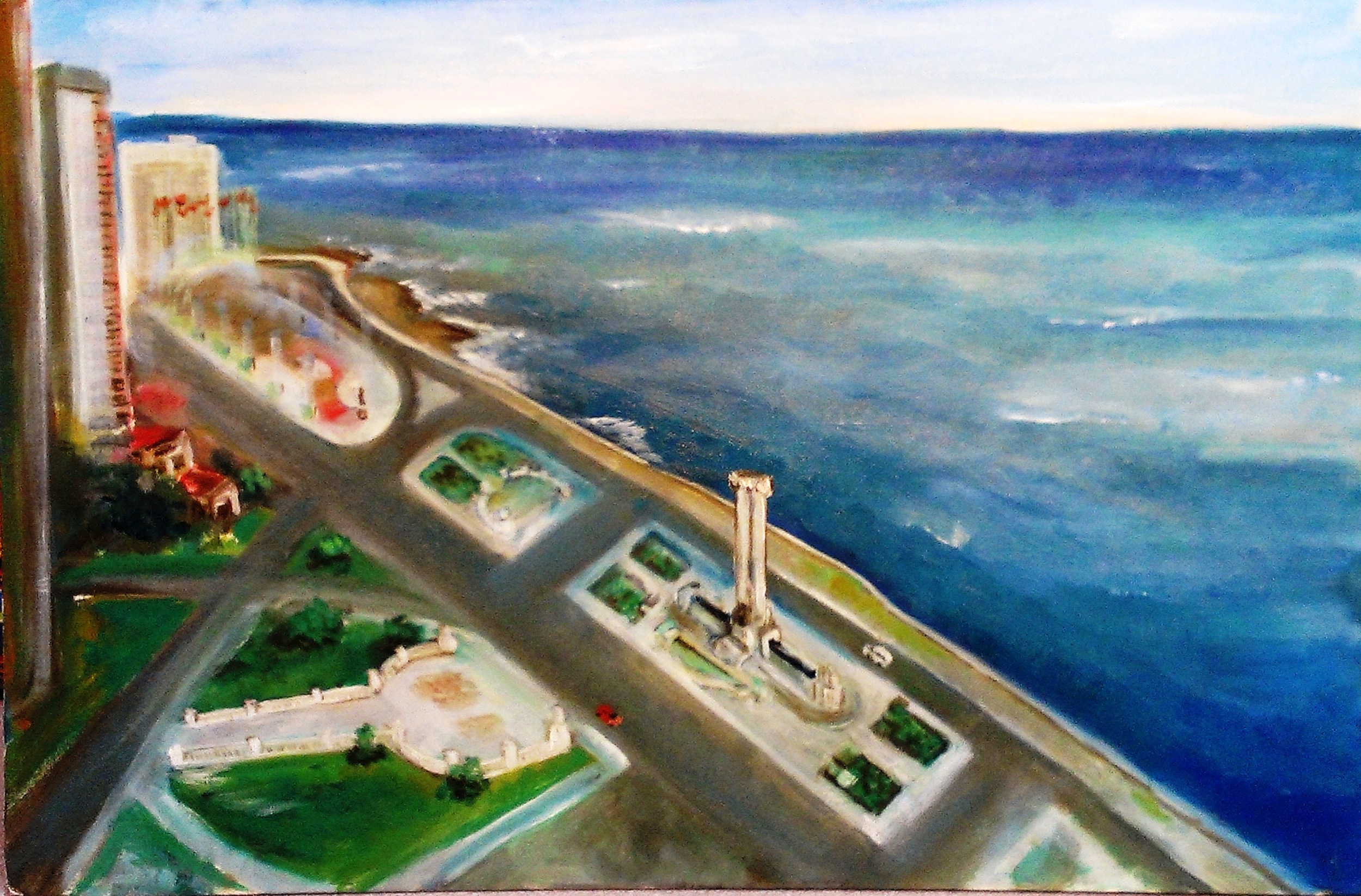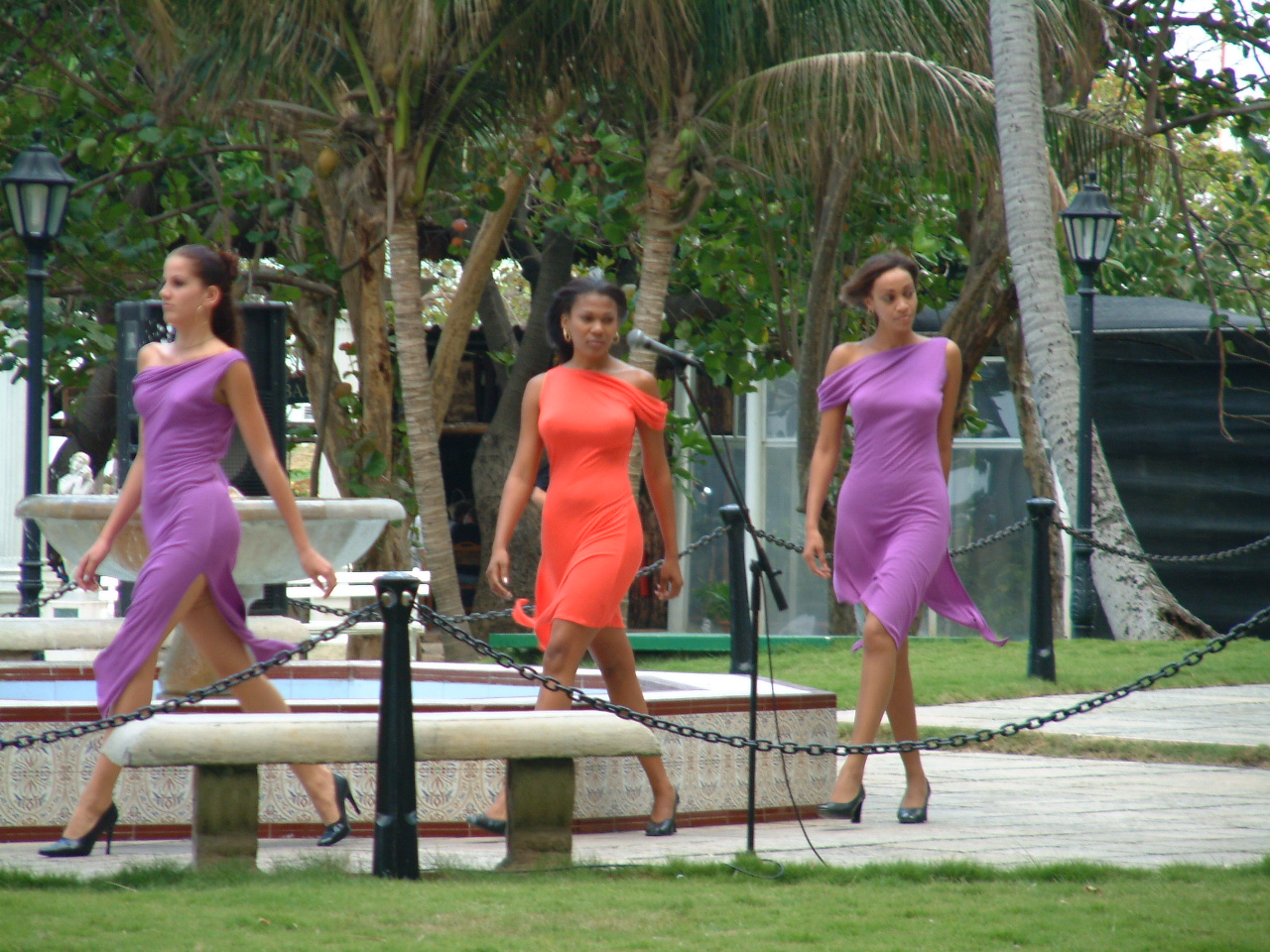THE MALECON in HAVANA, CUBA (photo gallery and story): WHAT WILL THEY DO WITH ALL THOSE FLAGPOLES?... or ONE IDEA FOR THE OBAMA – CASTRO MEETING.
Justin Lifflander
Havana, CUBA — Fiery red balls appear intermittently on the horizon, otherwise dark except for the distant twinkle of lights from a ship moving across the Gulf north of Havana. Is Key West being bombed? The trickle of sweat down my back reminds me that it’s 30 sultry degrees here in the garden behind the Hotel Nacional. I conclude that, barring some newfound geopolitical significance to Florida’s archipelago, it is merely heat lightening giving us well-irrigated spectators a free show.
The young waiter is baffled by my request for a shot of “Barrel Proof.” We walk together back up to the kiosk-bar and I learn that the product was rebranded “Seleccion de Maestros” a few years back. I should have stuck with Santiago. There is a fringe benefit to my cluelessness: if you pay cash at the kiosk-bar the charge is less than half what it would have been if I put it on my room. Entrepreneurism takes root! Although, since the Nacional is a state-owned facility, this manner of dispensing government owned property is what in the USSR we would have called “individual privatization.”
It’s a mixed bag at the La Barraca open-air restaurant on the other side of the lawn. They’ve run out of pork cracklings. The pig’s fatty skin was apparently sent elsewhere by the central planning commission. On the bright side, a new house band is hawking its CD, which I happily add to my collection. Surprisingly, the middle class Cuban émigrés, who seem to be present in greater numbers than usual, do not support the musicians. Probably, like everyone else on the planet, they came to “catch Cuba’s charm before it’s lost” thanks to the Americans. I think the urgency is misplaced. Anyway, I find their comfortable appearance an odd contrast to their dog eared former countrymen who are sitting on dark doorsteps, balconies and crumbling garden walls in the blocks around us, fanning themselves in the muggy evening.
The romance of the hotel’s garden scene pales in comparison to the human mass lined up along the Malecon promenade. I decide to wander in that direction, remembering as I head out the front door that there is actually a new sight to see—an uncommon opportunity for the generally static city.
The path to the Malecon is treacherous for the unwary rummy. First you must brave the intentionally jagged configuration of the hotel sidewalk curb as you head to O Street. It’s a shape leftover from some obscure pre-revolutionary parking scheme, leaving the width of the sidewalk varying from 20 centimeters to 1.5 meters. If you’ve made it to the exit gate without spraining an ankle, you turn right and pause to enjoy the view down the hill to the water. But beware the lone tree on the east side of the street, which grows between the sidewalk and the curb. It shoots up on a brief vertical trajectory, then juts horizontally across your path at chest height (or head height, depending on your stature). The choice is yours: be knocked unconscious or yield to its presence and remove yourself from the path for a moment – if you’ve noticed it in time.
The monument to the Maine at the foot of the hill remains unchanged, its dry pools collecting the litter of near constant celebration on the promenade. The occupiers of the sea wall are a mix of families drinking from water bottles and teenagers, often in freaky haircuts that have become fashionable, liberally imbibing state subsidized rum. But the presence of people staring at their smart phone screens as moronically as anyone in the Capitalist world attests to hints of increasing disposable income and gradual liberalization of access to the Internet.
The sign says “No swimming or Fishing,” but nothing prohibits a sexual encounter on the coral shelf just beyond the wall—at low tide of course. The empty condom wrappers littering the Malecon evidence success. But it’s not safe for the tipsy tourist to attempt vicarious gratification and peep, ere the cracks in the pavement succeed in wrenching an ankle where the Nacional sidewalk failed. Better to enjoy the people-watching on the illuminated side of the wall. Engage the curious locals, who will often say, “Hey, where you from?” the moment your eyes meet theirs. Many speak English and a few of the older ones will be happy to converse in Russian. In addition to the fundamental joy of making contact, chatting with the Habaneros will help keep you dry: they never sit in the spots where the swells crash unexpectedly over the wall.
Jose Marti is one resident of the Malecon whose message doesn’t change. A bronze rendition of the national hero stands in the dim light at the vertex of Anti-Imperialist Park, a baby clutched in one arm, the other pointing accusingly at the newly inaugurated US Embassy. The building had been the unsanctified headquarters of American interests on the island for many years prior to the recent thaw. As I walk past the statue I recall the tens of thousands of revelers who had gathered in this place in December of 2009 for a free concert by Kool & The Gang. It was a CELEBRATION that even Sr. Marti’s glare couldn’t spoil.
The American flag now flies proudly from a pole in the front yard of the building, though the glow from an energy-efficient streetlight on one side and the moon floating above create a slight aura of contrition— at least in my mind.
My spider-sense tells me the Cuban police guards around the structure are less tense than in the past. Normally quick to discourage any wandering individual from approaching the facility, they take no notice as I stroll behind the building and continue my circumnavigation. Meanwhile a stray dog walks along the embassy fence, oblivious to the rules. Or have the Russians sent an animatronic drone, sniffing for hints of where this unexpected shift in the geopolitical landscape is heading? I would if I were them.
And what of the forest of flagpoles in that park between Marti and the embassy, planted by Castro in 2006? The enormous Cuban flags they flew were a countermeasure to a now extinguished Bush-era propaganda ticker placed in the upper windows of the building that broadcast one-liners about freedom, democracy and the salaries of Cuban émigré baseball players.
My vision for Obama’s visit – a well-earned reward for one of the few foreign policy accomplishments in his tenure – includes a simple act of cooperation on both sides.
I see an official procession: the Castro brothers marching behind a twin oxy-acetylene tank cart, humbly being pulled by the US president. They pause at the first of the flagpoles. Senior Castro extracts from the breast pocket of his camo jacket a cigar from his unused (but properly maintained) collection. He clips off the cap and hands it to Obama. It is a colossal Cuaba Salomones. Cuaba: the brand named after the wood of the torches used by native Indians to drive away the devil. Salomon: representing the wisdom of compromise.
The fanfare of the marching band stationed on the Malecon dies down as the leader of the free world raises the stogie to his lips. Fidel produces a wind proof lighter and warms, then lights the president’s cigar. The president takes several glorious puffs, his eyes half closed as he contemplates what he’s been missing all these years. Then he withdraws the puro, bows slightly and thanks Fidel (in Spanish) for the smoke. The assembled crowd breaks into applause.
Meanwhile, Raul has cracked the valves on the cutting-torch. Obama takes another puff so the coal on the end glows bright red, then places it the path of the escaping gas. The flame ignites. After a few adjustments to the mix, Raul hands the torch handle to Secretary of State John Kerry, who adorned welding goggles in advance. The tall man smiles to the crowd, bends low to the base of the first flag pole, and begins to heat the metal….Good thing the boss is smoking a Salamones. This will take a while.
Artist’s rendition of how the summit might go. Credit: Natalie Lifflander
As I pass the families sitting on their makeshift patios on Calzada Street across from the park, I imagine they would enjoy such a spectacle unfolding before their eyes. And they’d appreciate the improved real estate value that comes with an unfettered view of the Gulf, not to mention Kool & The Gang.
Havana, August 2015








